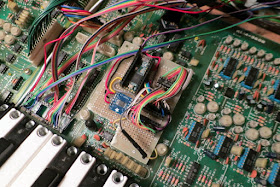 |
| A simple distortion generator: an LED, or a diode, or both! |
Classic Diode Distortion: Being a guitarist, I know that it is very difficult to simulate the sound and feel of a tube amp. So, instead of heading down that challenging path, I'll look to the well-known overdrive and distortion tricks used in guitar pedals. A very common technique used for guitar distortion is to use a pair of opposite-facing diodes in parallel. This is how distortion pedals such as the Ibanez Tubescreamer and the ProCo Rat achieve their classic sounds. Maybe it'll work well in my Polysix, too!
Putting Diodes in the Polysix: Below is an excerpt from the Polysix schematic. It shows the last VCA and the last amplifier prior to the audio signal being sent to the output jack. In the blue region, it shows that the make-up gain after the VCA is simply an op-amp configured as an inverting amplifier. Since the Tubescreamer also uses an inverting op-amp, I chose to follow the Tubescreamer's distortion approach of adding a pair of diodes into the op-amp's feedback loop. I just need to clip in a pair of diodes? That's it? Easy.
In Parallel with R196: In the modified schematic above, you can see that the pair of diodes are added in parallel with the other elements in the feedback loop. To enable a quick test, I simply attached the diodes using clip leads on either end of R196. The other ends of the clip leads (not shown) are clipped onto the diodes. The only tricky part is to make sure that the diodes face in opposite direction. I used my handheld multi-meter to determine which direction was "forward" for each diode, and then I swapped one of them around backwards.
 |
| Using small clip leads to attach my diodes (not shown) in parallel with R196. |
Looking at the Output: With the diodes hooked up, I used my oscilloscope to look at how the diodes affected the audio signal from the op-amp. The pictures below show some screenshots from the oscilloscope. To make a strong signal, I set the Polysix to play two voices at the same pitch. Then, I set the Polysix's "Attenuator" dial to maximum volume (ie, "+10dB"). Now the signal is strong enough to really show the effect of the diodes.
 |
| Screenshots of my oscilloscope when recording the output of the op-amp. I tried different combinations of diodes in the op-amp's feedback loop. |
Clipping of the Waveform: As can be seen in the top-left screenshot ("No Mods"), I've got a normal-looking sawtooth waveform. When I add just the LED, I see that the top of each sawtooth has been clipped to a maximum voltage of 1.6V (ie, the LED's forward voltage drop). When I swap out the LED for a backwards silicon diode, it's the bottom of the sawtooth that has been limited (clipped at 0.6V, which is the diode's forward voltage drop). Finally, when I have both the red LED with the backwards silicon diode in circuit, both the top and bottom of the waveform is clipped. So, the diodes act to distort the signal by limiting its dynamic range. Pretty sensible.
Demo: OK, these oscilloscope views are interesting and all...but how does it SOUND?!? That's a good question. Below is a short demo that I pulled together. It shows the baseline Polysix with no distortion mod, the Polysix with LED distortion only, and the Polysix with the LED + diode.
Not What I Wanted: By the end, my conclusion was that I didn't like the results. My first reaction was that the distortion was too fizzy/fuzzy. But, beyond just the fizzy sound, the diode distortion didn't have the right feel when playing it. I had been hoping that the distortion would provide a sense of dynamic compression, like a guitar amp feels. But, instead of feeling that kind of compression, I actually felt like the signal was being hard limited...which, of course, is exactly what diodes do. I should not have been surprised at this disappointment.
Moving Forward: Yes, I could have spent more time refining this diode distortion modification to try to address my criticisms. For example, to reduce the fizzy/fuzzy sound, the Tubescreamer includes additional capacitors to reduce the high frequency sizzle. I could have tried that. But, in truth, this experiment reminded me of why I don't use diode-based distortion pedals with my guitar...I never end up liking the sound. So, for my Polysix, I'm going to leave behind the diodes and try some other approaches. Let the synth hacking continue!
Update: I've removed the diode distortion and, instead, modded the Polysix to overdrive one of its OTAs. I like that sound much better!




